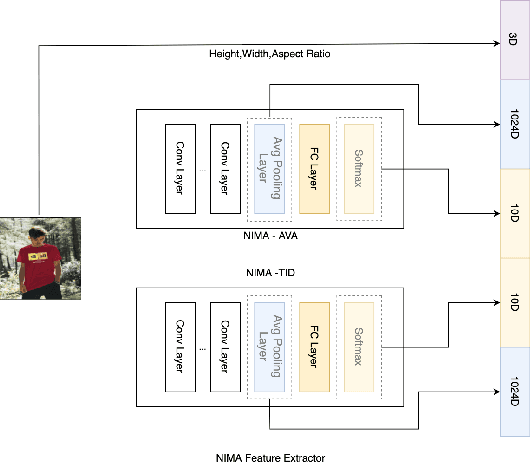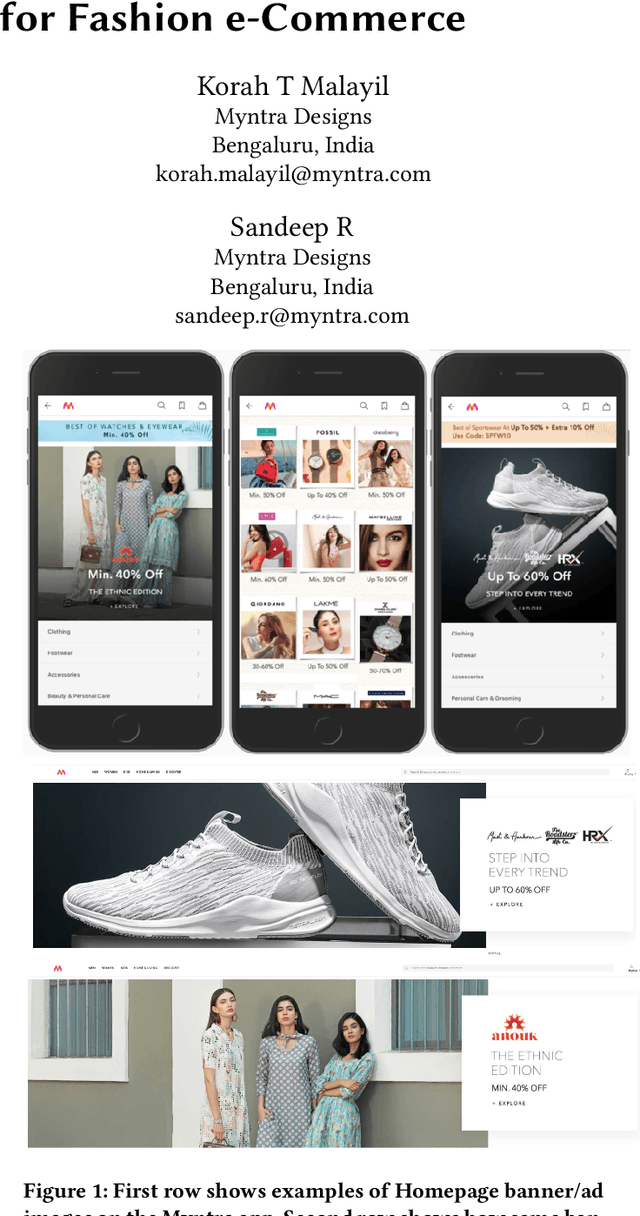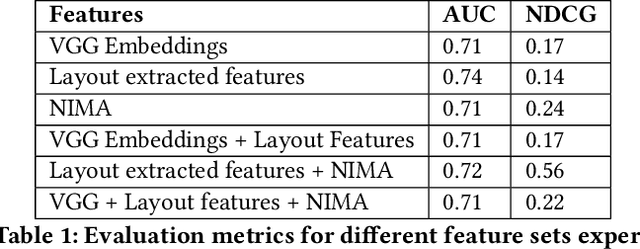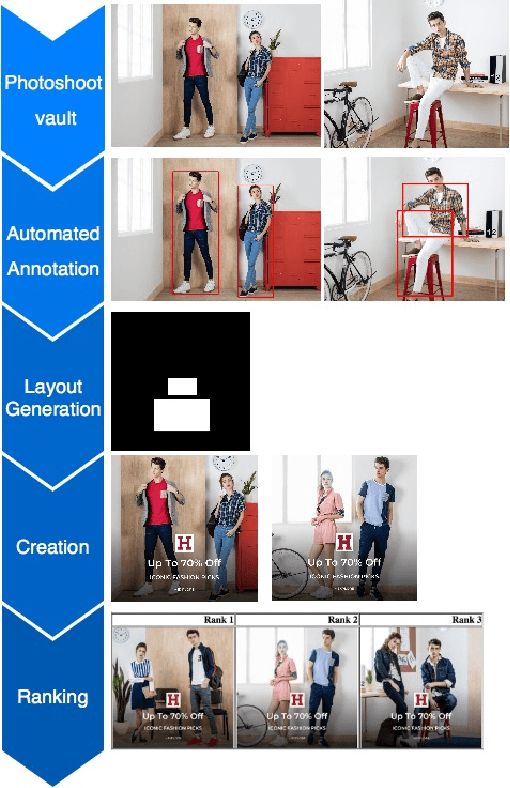Sreekanth Vempati
Diversify and Conquer: Bandits and Diversity for an Enhanced E-commerce Homepage Experience
Sep 25, 2023Abstract:In the realm of e-commerce, popular platforms utilize widgets to recommend advertisements and products to their users. However, the prevalence of mobile device usage on these platforms introduces a unique challenge due to the limited screen real estate available. Consequently, the positioning of relevant widgets becomes pivotal in capturing and maintaining customer engagement. Given the restricted screen size of mobile devices, widgets placed at the top of the interface are more prominently displayed and thus attract greater user attention. Conversely, widgets positioned further down the page require users to scroll, resulting in reduced visibility and subsequent lower impression rates. Therefore it becomes imperative to place relevant widgets on top. However, selecting relevant widgets to display is a challenging task as the widgets can be heterogeneous, widgets can be introduced or removed at any given time from the platform. In this work, we model the vertical widget reordering as a contextual multi-arm bandit problem with delayed batch feedback. The objective is to rank the vertical widgets in a personalized manner. We present a two-stage ranking framework that combines contextual bandits with a diversity layer to improve the overall ranking. We demonstrate its effectiveness through offline and online A/B results, conducted on proprietary data from Myntra, a major fashion e-commerce platform in India.
Product Review Image Ranking for Fashion E-commerce
Aug 10, 2023



Abstract:In a fashion e-commerce platform where customers can't physically examine the products on their own, being able to see other customers' text and image reviews of the product is critical while making purchase decisions. Given the high reliance on these reviews, over the years we have observed customers proactively sharing their reviews. With an increase in the coverage of User Generated Content (UGC), there has been a corresponding increase in the number of customer images. It is thus imperative to display the most relevant images on top as it may influence users' online shopping choices and behavior. In this paper, we propose a simple yet effective training procedure for ranking customer images. We created a dataset consisting of Myntra (A Major Indian Fashion e-commerce company) studio posts and highly engaged (upvotes/downvotes) UGC images as our starting point and used selected distortion techniques on the images of the above dataset to bring their quality at par with those of bad UGC images. We train our network to rank bad-quality images lower than high-quality ones. Our proposed method outperforms the baseline models on two metrics, namely correlation coefficient, and accuracy, by substantial margins.
Learning-To-Embed: Adopting Transformer based models for E-commerce Products Representation Learning
Dec 07, 2022



Abstract:Learning low-dimensional representation for large number of products present in an e-commerce catalogue plays a vital role as they are helpful in tasks like product ranking, product recommendation, finding similar products, modelling user-behaviour etc. Recently, a lot of tasks in the NLP field are getting tackled using the Transformer based models and these deep models are widely applicable in the industries setting to solve various problems. With this motivation, we apply transformer based model for learning contextual representation of products in an e-commerce setting. In this work, we propose a novel approach of pre-training transformer based model on a users generated sessions dataset obtained from a large fashion e-commerce platform to obtain latent product representation. Once pre-trained, we show that the low-dimension representation of the products can be obtained given the product attributes information as a textual sentence. We mainly pre-train BERT, RoBERTa, ALBERT and XLNET variants of transformer model and show a quantitative analysis of the products representation obtained from these models with respect to Next Product Recommendation(NPR) and Content Ranking(CR) tasks. For both the tasks, we collect an evaluation data from the fashion e-commerce platform and observe that XLNET model outperform other variants with a MRR of 0.5 for NPR and NDCG of 0.634 for CR. XLNET model also outperforms the Word2Vec based non-transformer baseline on both the downstream tasks. To the best of our knowledge, this is the first and novel work for pre-training transformer based models using users generated sessions data containing products that are represented with rich attributes information for adoption in e-commerce setting. These models can be further fine-tuned in order to solve various downstream tasks in e-commerce, thereby eliminating the need to train a model from scratch.
Enabling Hyper-Personalisation: Automated Ad Creative Generation and Ranking for Fashion e-Commerce
Aug 27, 2019



Abstract:Homepage is the first touch point in the customer's journey and is one of the prominent channels of revenue for many e-commerce companies. A user's attention is mostly captured by homepage banner images (also called Ads/Creatives). The set of banners shown and their design, influence the customer's interest and plays a key role in optimizing the click through rates of the banners. Presently, massive and repetitive effort is put in, to manually create aesthetically pleasing banner images. Due to the large amount of time and effort involved in this process, only a small set of banners are made live at any point. This reduces the number of banners created as well as the degree of personalization that can be achieved. This paper thus presents a method to generate creatives automatically on a large scale in a short duration. The availability of diverse banners generated helps in improving personalization as they can cater to the taste of larger audience. The focus of our paper is on generating wide variety of homepage banners that can be made as an input for user level personalization engine. Following are the main contributions of this paper: 1) We introduce and explain the need for large scale banner generation for e-commerce 2) We present on how we utilize existing deep learning based detectors which can automatically annotate the required objects/tags from the image. 3) We also propose a Genetic Algorithm based method to generate an optimal banner layout for the given image content, input components and other design constraints. 4) Further, to aid the process of picking the right set of banners, we designed a ranking method and evaluated multiple models. All our experiments have been performed on data from Myntra (http://www.myntra.com), one of the top fashion e-commerce players in India.
 Add to Chrome
Add to Chrome Add to Firefox
Add to Firefox Add to Edge
Add to Edge